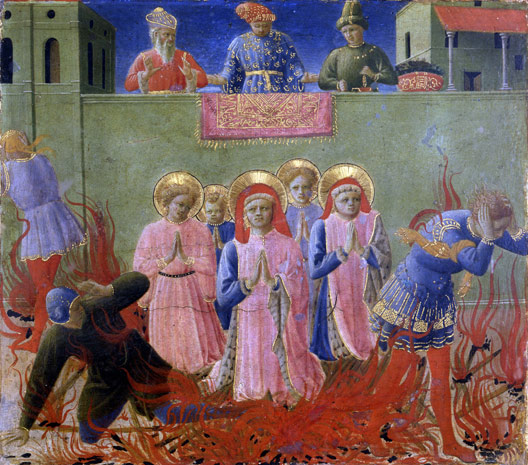Fr : version française / En: english version
Show me a sign
By what miracle did Saint Cosmo and Saint Damian (and their three brothers) repel the flames by driving them toward their executioners and escape all the atrocities Proconsul Lilias carried out against them? Seeing justice done can be quite complicated, especially in the absence of proof or witnesses. That is why it was long left up to God to recognize his own through trial by ordeal, or divine judgment. The principle was simple: the accused was asked to grab hold of an iron bar heated until it was red hot in the fire and the extent of the injury was studied to decide his or her fate, based on the premise that God would not condemn an innocent.
Forcing the divinity to take sides for justice
From France to Polynesia, Scandinavia to Africa's farthest reaches, there may be no country in the world that does not subject people to mortal trials in order to make their case or prove their innocence. Trial by hot or cold water, by fire or poison: the means do not matter. At a particular stage in social and religious development, the community is convinced that the best way to end a dispute is to expose at least one person involved to a grave danger and thereby force the divinity to take sides on behalf of justice. The idea manifested in this fearsome and sacred process is clearly apparent in a preliminary rite.At the moment of climax, those entreating heaven to intervene, especially the one whose body is about to be subjected to the trial, say a prayer, a direct and formal appeal to divine providence. In societies in which the priesthood is a separate caste, the man of God steps forward to pronounce the solemn invocation. Buddhist priests address the flaming fire, saying "0h fire, you live within each creature and are witness to it; you alone know what mortals cannot comprehend. The accused stands before you and awaits his vindication. Protect him from the harm of the ordeal he is about to endure."
Excerpt from "Études sociales et juridiques sur l'antiquité grecque"/Social and Legal Studies of Greek Antiquity by Gustave Glotz, 1906
Free translation from the French
Even today we still make fire speak: traffic lights and beacons provide injunctions that keep us all safe.





























